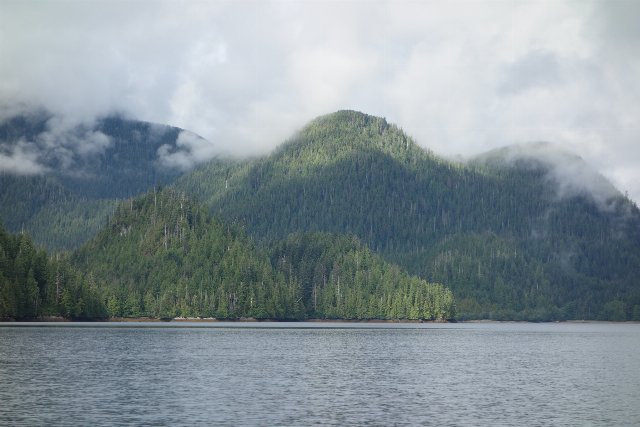Home » Regions » North America » Marine West Coast Forest » Coastal Western Hemlock-Sitka Spruce Forests
Coastal Western Hemlock-Sitka Spruce Forests
Last updated: August 16th, 2022
Page contents
↑About the Coastal Western Hemlock-Sitka Spruce Forests
The Coastal Western Hemlock-Sitka Spruce Forests stretch from near Homer, Alaska, through coastal Alaska and British Columbia, ending near the southern end of Vancouver Island. The region is narrower at its northern end and broader in the south.This region consists mostly of mountains, often quite steep right up to the coastline, which consists of numerous inlets and sounds, often bordered by cliffs. Valleys are U-shaped, having been formed by glaciers during colder times. The region has a marine west coast climate, with some seasonality of precipitation; in the south of the region the rainfall peaks in winter and is lowest in summer, whereas in the central to northern portions it tends to peak in September and is lower in late spring to early summer. Summers are cool and winters are cold but usually free of severe weather, and temperatures tend to be predictable year-round. Numerous streams of moderate-to-high gradient flow into the Pacific ocean. Soils tend to be acidic with extensive leaching of surface minerals on well-drained sites, reflecting the high rainfall and the fact that most soils here formed under coniferous forest.
This region is naturally covered mostly in coniferous forests. Low elevations are dominated by western hemlock (Tsuga heterophylla), douglas-fir (Pseudotsuga menziesii), and Pacific silver fir (Abies amabilis), which meets its northern range limits in this region. Drier sites support a mix of western hemlock, western redcedar (Thuja plicata), and Sitka spruce (Picea sitchensis). Higher elevations support mountain hemlock (Tsuga mertensiana), subalpine fir (Abies lasiocarpa) and Pacific silver fir, with some Alaska cedar (Callitropsis nootkatensis). The coldest, highest-elevation sites support alpine tundra with dwarf willow, sedge, fescue, and various herbaceous plants.
Most of this region is sparsely populated, with settlements located only along the water. Prince Rupert, BC is the largest city whose metro area is contained entirely within this region. Juneau, Alaska lies just at the inland border of this region. The region also contains some smaller settlements, mostly either near its northern end, including Cordova, Homer, and Ketchikan, or its southern end on Vancouver Island, including Port Hardy, Port McNeill, Tofino, and Ucluelet. The sparse population in this region mostly reflects the terrain, with steep mountains making it difficult to build road access between here and inland population centers. Prince Rupert is the sole exception to this trend, with road access inland along the Skeena river, one of the few rivers with a broader valley connecting to inland regions.
This region is used primarily for forestry, both for pulp and lumber, and is among the most productive forest land in North America. There is also some mining, tourism, and water-centered recreation. The region is also used as a base for commercial fishing, and there is also a significant amount of subsistence fishing, hunting, and gathering, with many indigenous people living traditional lifestyles. There are significant areas of public, protected land.
In the north of this region, it is bordered inland by the Pacific Coastal Mountains, and in the south, by the Pacific and Nass Ranges; both of these regions reach to higher elevations and have more extreme climates, particularly cold winters, and have glaciers at the higher elevations. At the far north there is also a small border with the Cook Inlet to the northeast, and the Alaska Peninsula Mountains to the west. The southernmost end of this region, on Vancouver Island, borders the Puget Lowlands / Georgia Depression, a lower-elevation region with more moderate temperatures, which is also heavily populated.
 This picture of the coastline of Haida Gwaii, BC, shows scenery typical of the Coastal Western Hemlock-Sitka Spruce Forests: steep, mountainous terrain descending to the ocean. Photo © Olivier Bruchez, CC BY-SA 2.0, Source.
This picture of the coastline of Haida Gwaii, BC, shows scenery typical of the Coastal Western Hemlock-Sitka Spruce Forests: steep, mountainous terrain descending to the ocean. Photo © Olivier Bruchez, CC BY-SA 2.0, Source.

